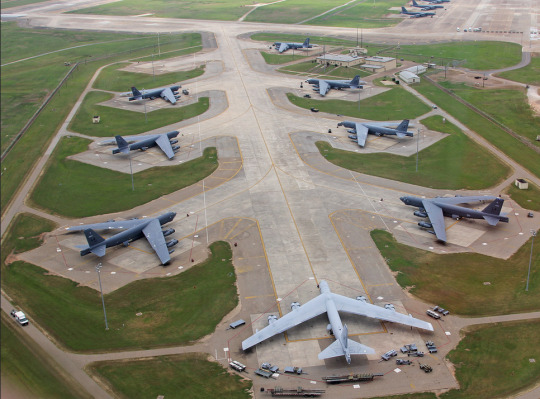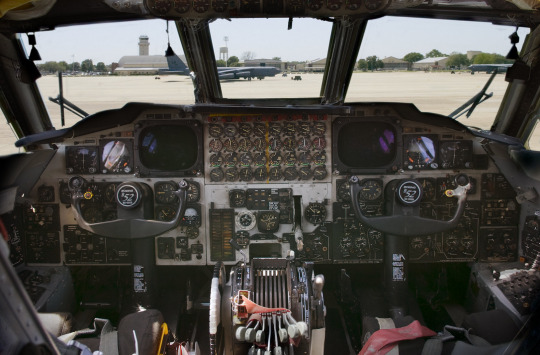#Barksdale AFB
Explore tagged Tumblr posts
Text

"Christmas Tree"
#USAF#SAC#Strategic Air Command#Christmas Tree#Barksdale AFB#Alert Ramp#Boeing#B-52#Stratofortress#Bomber#military#cold war
205 notes
·
View notes
Text

Strike Eagles at Barksdale AFB
@kadonkey via X
#f 15e eagle#mcdonnell douglas aviation#fighter bomber#aircraft#usaf#mudhen#aviation#cold war aircraft#undefeated
137 notes
·
View notes
Text

An airman from the US Air Force Security Police guards a B-52G Stratofortress from the 2nd Bomber Wing as its being loaded with AGM-86 ALCM cruise missiles as part of a combat readiness review conducted by Strategic Air Command; Barksdale AFB, December 1986
61 notes
·
View notes
Text
Has seen better days...

Some Blackbird chunks being re-assembled at the Global Power Museum at Barksdale AFB.
Sheesh. Show some respect.
2 notes
·
View notes
Text

"At Barksdale Air Force Base (AFB), Louisiana, members of the Mishap Investigation Team (MIT) inspect and prepare debris from the Space Shuttle Columbia (STS-107) for shipment to the Kennedy Space Center, Florida."
Date: February 10, 2003
NARA: 6633277
#STS-107#Space Shuttle#Space Shuttle Columbia#Columbia#OV-102#Orbiter#NASA#Space Shuttle Program#February#203#Louisiana
12 notes
·
View notes
Text
"Captain, they appear to be broadcasting a frequency modulated electromagnetic signal. The computer is decoding the patterns... It is audio only."
"Put it on speaker, Ensign."
"Sir."
There was a crackle of static, and then a voice said "-peating, this is Bravo Uniform Foxtrot Four Niner, requesting navigational update and bearing to Barksdale AFB, over."
The Captain looked at his bridge crew. They looked back at him, equally mystified. He looked at the Ensign seated at the Comms console.
"Mr Travis, can you reproduce their emission pattern and broadcast to them?"
Travis nodded and tapped at his console for a few seconds. "Channel is open, sir."
"Attention unidentified craft. This is Captain Bowie of the Imperial Texan Fleet. You are currently thirty-eight light minutes away from Barnard's Star and approximately five point nine six light years off course."
There was silence for several seconds. Then the voice came from the bridge speakers again.
"... Told you we should have turned left at Alberqueque."
“Captain, a human starship has shown up on scanners.” “What is it’s designation?” “They call it a B-52” “Isnt that a plane from 200 years ago?” “Yes”
5K notes
·
View notes
Text
F15 E fighters Seymour Johnson and B52 Bombers Barksdale AFB. Full flightline.

60 notes
·
View notes
Text

View of the Barksdale Air Force Base flight line from inside a B-52
#Barksdale AFB#Flightline#apron#Boeing#B-52#Stratofortress#Bomber#cockpit#B-52 cockpit#Military#Air Force Base
36 notes
·
View notes
Text

Reassembly at the Global Power Museum at Barksdale AFB. (Michael A. Kaplan, USAF)
@kadonkey via X
#sr 71#sr 71 blackbird#sr71#blackbird#aircraft#usaf#lockheed aviation#skunkworks#aviation#mach3+#habu#reconnaissance#cold war aircraft
38 notes
·
View notes
Text
USAF May Put B-52 Bombers on Full 24 Hour Alert
USAF May Put B-52 Bombers on Full 24 Hour Alert
In a move not seen since the Cold War, the USAF may put their B-52 Bombers on 24 hour alert status, according to Defense One. NO alert order has yet been given, but preparations are currently underway just in case it comes. “This is yet one more step in ensuring that we’re prepared. I look at it more as not planning for any specific event, but more for the reality of the global situation we find…
View On WordPress
2 notes
·
View notes
Video
Returned to USAF service - B-52H 60-0034 Wise Guy by Duncan Monk Via Flickr: Seven B-52's sit awaiting their fate at the Boneyard, AKA AMARC at Davis-Monthan, Tucson, Arizona. Of note the top right ex Minot AFB B-52H 60-0034 'Wise Guy' was returned to service and flown to Barksdale in May of 2019, some 15 months after this image was taken.
#USAF#B52#Bomber#Bombers#Barksdale#60-0034#0034#Wise#Guy#Boneyard#Bone#Yard#AMARC#AMARG#Davis#Monthan#AFB#Tucson#Arizona#Overflight#Buff#wiseguy
28 notes
·
View notes
Photo

Enjoy the pictures? Follow me on facebook, too :) facebook.com/Kindarandomphotography
And I’m on flickr as well! https://www.flickr.com/photos/kindarandomphotography/
if you want to make it possible for me to take even more pictures, please consider buying me a coffee ;) https://ko-fi.com/kindarandomphotography
Please don’t forget to like and share :) :) :)
#air force#military#airplain#aeroplane#blue#blue sky#b-52 bombers#b-52 stratofortress#b-52s#b-52#air show#barksdale afb#barksdale
3 notes
·
View notes
Text

A B-52 Stratofortress from Barksdale AFB lands on the flight line at Fairchild Air Force Base, Washington, Aug. 16, 2022. The B-52s landed at Fairchild to conduct their own Agile Combat Employment exercise creating more multi-capable Airmen ready to deploy anywhere, anytime. (U.S. Air Force photo by Staff Sgt. Lawrence Sena)
116 notes
·
View notes
Text

A B-52 from the 2nd Bomb Wing at Barksdale AFB, Louisiana seen flying out of Nellis AFB, Nevada
#USAF#Boeing#B-52#Stratofortress#Bomber#Iconic aircraft#warplane#combat aircraft#airpower#Military jets
78 notes
·
View notes
Text

A Barksdale B-52 arrives at Nellis AFB for Red Flag 25-1, Jan 23rd. Nice backdrop😎 #Vegas [USAF Pic]
@Saint1Mil via X
32 notes
·
View notes
